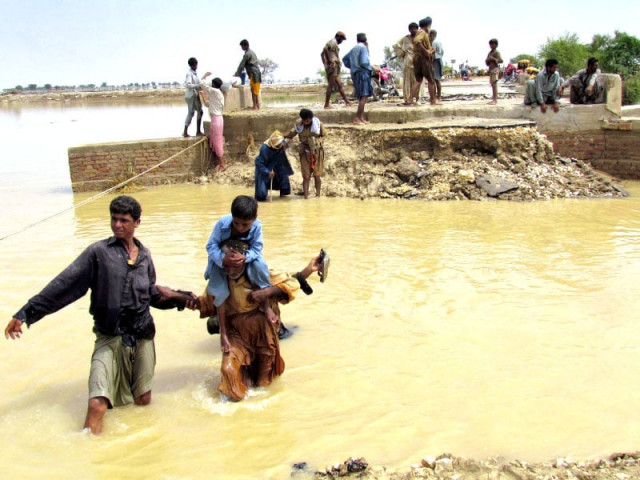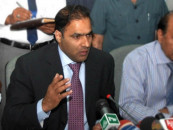Devastating monsoon: Sindh, Balochistan hit much worse than Punjab
Unlike Punjab, no organised relief effort by government and NGOs was witnessed.

While the recent monsoon rains wreaked widespread havoc in Punjab, the situation in Sindh and Balochistan paints an even more dismal picture.
The second day of the National Disaster Management Authority (NDMA)-arranged trip to the flood-affected areas for select journalists, government officials and UN representatives, took the group to two districts in Sindh and three districts in Balochistan.
Briefing journalists and officials regarding the situation in western Sindh, provincial disaster management authority (PDMA) Director General (DG) Hashim Zaidi placed the number of people affected by the floods in the region at two million.
“The floods have pushed people from five districts of Sindh below the poverty line,” Zaidi said.
Zaidi focused his briefing on Kashmore and Jacobabad districts in particular. Talking about confirmed casualties in the two districts so far, he said 21 people were killed in Kashmore, while six were killed in Jacobabad. The number of injured people in both districts stood at 46 and 39, respectively.
A PDMA handout further revealed that another 21 people were killed and 74 were injured in Shikarpur.
Around 90% of all crops in the three districts have been destroyed. Meanwhile, in Jacobabad, 0.2 million houses have been completely or partially damaged by the floods. Around 30,000 families in Kashmore district’s Tangwani tehsil are still stranded at the rooftops of their houses.
In Balochistan, we visited Jaffarabad and Nasirabad districts. While the number of casualties in the districts remains unconfirmed, the briefing by Balochistan home secretary Naseebullah Khan and PDMA DG Tahir Munir revealed that 98 per cent of the people in the two districts were affected by the floods. In addition, 100 per cent of all crops have been destroyed; In Jaffarabad alone, 0.15 million acres of agricultural land remains under water.
An aerial view of the districts revealed both urban and rural areas were inundated with water four to five feet deep. Interestingly, Jacobabad airbase also appeared to be inundated. Several F-16s were seen outside their hangars.
All offices and schools remained closed in the districts. Many clung to main roads and highways, which seemed to be the only patches of dry land in various areas. Locals complained they had no food or drinking water.
Talking to The Express Tribune, Jacobabad district health officer Dr Dara said the situation was likely to worsen in a few days due to possible outbreaks of waterborne diseases.
Unlike Punjab, there was no trace of organised relief effort by the government and NGOs in these districts. Only a handful of trucks carrying relief supplies were seen. The Pakistan Army is so far the only entity carrying out relief operations in the area.
Pakistan Peoples Party (PPP) Kashmore president Fida Gilani said NDMA and the federal government had completely ignored flood victims in Sindh.
“There is no relief for three million people in Kashmore and Jacobabad facing the worst kind of disaster,” Gilani claimed.
PPP MNA Ejaz Jakhrani echoed Gilani’s sentiments. “The present government is sleeping,” he claimed, adding that there was no coordination between NDMA and PDMA in dealing with the disaster.
The affected districts’ governments have forwarded their demands to the government. In addition to seeking relief supplies to alleviate the situation, such as tents, medicines, drinking water and dewatering pumps, they have asked for Rs50million in reconstruction funds for each flood-stricken district. They further demanded that the government declare the districts calamity-hit areas.
So far NDMA has announced 2,500 tents each for districts in Sindh and Balochistan.
Meanwhile, federal minister for climate change Rana Farooq Saeed Khan, who was part of NDMA-arranged trip, was supposed to meet President Asif Ali Zardari on Thursday night to brief him on the latest flood situation in the country and recommend a course of action. At the same time, President Zardari directed federal information technology minister Mir Changez Khan Jamali, also part of the trip, to oversee the relief effort in Balochistan.
A high level meeting of top officials was also held in Quetta on Thursday to review the overall flood situation. The meeting resolved that the irrigation department will dispatch all machinery to the Kirthar Canal to meet any emergent situations.
Published in The Express Tribune, September 14th, 2012.



















COMMENTS
Comments are moderated and generally will be posted if they are on-topic and not abusive.
For more information, please see our Comments FAQ